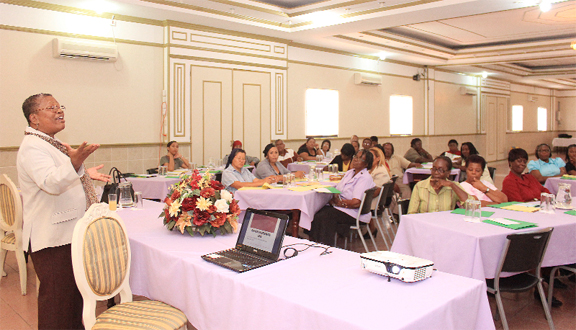The conditions at children’s homes throughout the country are alarming and administrators are being urged to work towards meeting the standards for child care ahead of plans to make licensing of such facilities mandatory later this year.
“Soon homes will be licensed. Right now, it’s voluntary. But, in keeping with the Child Care and Development Services Act, that has made provisions for all daycares and residential homes to be licensed, we have to perfect the minimum standards that we had since 2008 and trust that when its licensing time we are okay,” Director of Children Services at the Child Care and Protection Agency (CC&PA) Ann Greene said yesterday.

country’s 23 children’s homes at a workshop at the Regency Hotel yesterday. (Arian Browne photograph)
She was at the time speaking to administrators from the country’s 23 children’s homes at a workshop held at the Regency Hotel at Hadfield Street.
“If you are serious about caring for children you will have standards,” she said, while noting that it is a responsibility of homes to meet requirements needed to properly care for the children.
According to the Deputy Director of Children Services at the CC&PA Teresa Gaime, much was found wanting at homes visited by the Human Services Ministry’s visiting committees, which make impromptu visits to homes and evaluate their standards.
Some homes, Gaime noted, were rodent-infested, some improperly stored food and some had appalling sanitary conditions. The committees also examined the physical conditions of the properties and found that many of them have leaky roofs, broken bathroom and toilet facilities and windows missing or broken, leaving children to the elements. “The sanitation conditions of most homes visited have been a general concern, with cases of rodent infestation… improper storage of food… need for some structural work to be done …bathrooms and roofs being in need of repairs…,” she said.
Absent from all of the homes were safety procedures and fire drills. This, Gaime said, is alarming as it should be one of the first safety mechanisms that children living in the homes should be taught.
Meanwhile, some of the administrators complained that it was a difficult task maintaining the homes, especially the toilet facilities, given the number of children they were accommodating and the diverse sanitary situations the children were exposed to prior to living at the homes.
Greene, while noting their concern, would not accept this justification and she urged them to find alternative avenues in sensitising the children on the importance of sanitation.
Another issue among some the administrators was CC&PA’s impromptu visits and some questioned why they could not be notified of visits.
“No. It defeats the purpose…we want to come when you least expect it, because we don’t ‘window dress.’ When persons know we are coming, it’s one big show. There will be teddy bears lined off, everything spic and span, to give us the impression all is well,” Greene said.
At the end of the workshop, she said that she was pleased with the response and is now looking to gear her ministry to reach out to the public so that family members return for the children. “We want the public to know that institutions should be a last resort. We are promoting family-based care, so children should be cared for in a family,” she said.





